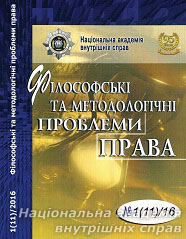Criminal and legal characteristics and its methodological essence
Keywords:
criminal and legal characteristics, criminal and legal characteristic of crime, crime, corpus delicti, qualification, category
Abstract
The article defines the notion of the criminal and legal characteristics, discloses its connection with the other sciences. The author classified the criminal and legal characteristics of crimes, outlined and disclosed the contents of the general, generic, specifics and individual criminal and legal characteristics of crimes. The author found out interrelation with the other sciences and methods of scientific cognition. It is defined the criminal and legal characteristics of crimes. The methodical and integrated essence of the criminal and legal characteristics was outlined in terms of studying the criminal and legal characteristics.Downloads
Download data is not yet available.
Abstract views: 288 PDF Downloads: 122
Issue
Section
Specific Areas of Legal Philosophy (Ontology, Gnoseology, Anthropology, Praxeology)
Copyright (c) 2017 Philosophical and Methodological Problems of Law

This work is licensed under a Creative Commons Attribution-NonCommercial-NoDerivatives 4.0 International License.
- Authors reserve the right to authorship of their own work and transfer to the magazine the right of the first publication of this work under the terms of the Creative Commons Attribution License, which allows other persons to freely distribute published work with mandatory reference to authors of the original work and the first publication of an article in this magazine.
- Authors have the right to enter into separate additional agreements on non-exclusive dissemination of the work in the form in which it was published in the journal (for example, to post an article in the institution's repository or to publish as part of a monograph), provided that the link to the first publication of the work in this journal is maintained.
- The journal's policy allows and encourages the posting of articles by authors on the Internet (for example, in electronic storehouses of institutions or on personal websites), both before the submission of this manuscript to the editorial office and during its editorial processing, as this contributes to the creation of a productive scientific discussion and positively affects the efficiency and dynamics of citing the published work.




